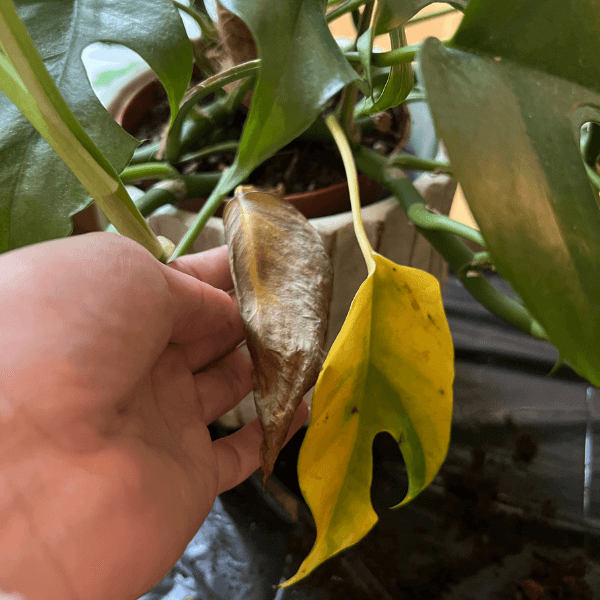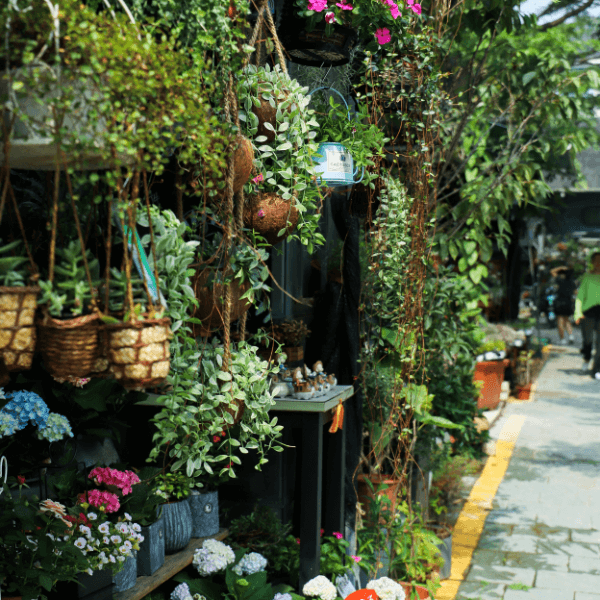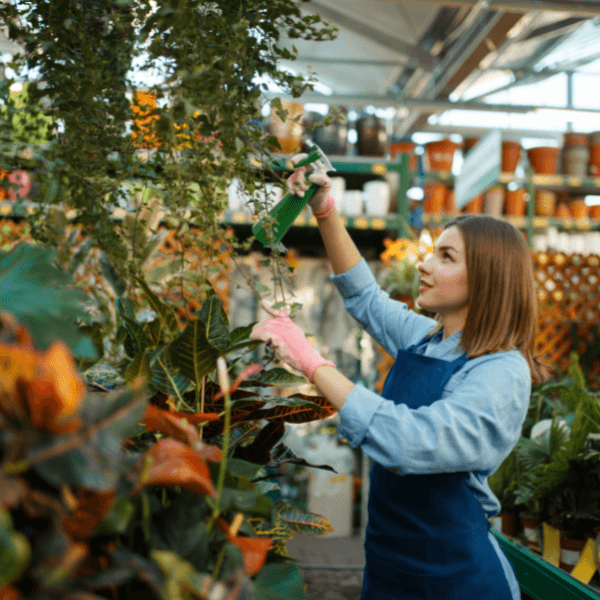Every plant parent’s dream is to make their philodendron feel comfortable in their home. However, there are still times when it doesn’t like something. The good news is that Philodendrons show clear signs of dislike and are relatively easy to treat.
If your leafy friend doesn’t like something, yellowed leaves are one of the first signs. It can be easily recognized, as they stand out well among the green foliage. Yellow leaves can also accompany drooping growth, brown spots or discolored leaf edges, stunted growth, and many other symptoms. It is impossible to turn discolored leaves back to green once they have turned.
You might feel anxious when you see your first brown or yellow leaf, but do not panic. Various factors can cause yellow leaves, but not all are serious.
This article explains how to identify and treat problems your philodendron may encounter. We’re focusing on finding out what might be causing your plant’s discolored leaves. Keep calm and start an investigation.
What causes my plant’s leaves to turn yellow or brown?
As a result of disrupting vital processes, a plant’s leaves turn brown or yellow as a plant cannot correctly photosynthesize. Due to this, plants cannot get all the nutrients they need. So survival mode kicks in. As a side note: Plants require photosynthesis to survive. Leaves create oxygen and energy by converting light, water, and CO2.
The plant does not need all its leaves in survival mode. To survive, they keep their leaves to a minimum. Leaf by leaf, the remaining leaves will turn yellow and fall off. Identifying the problem as soon as possible is crucial to prevent further damage.
As I said before, multiple factors can cause discolored leaves. Here are some of the most common causes:
- Too much water
- Not enough water
- Too intensive light
- Not enough light
- It’s too cold
- Lack of nutrients
- Overfeeding
- Compacted roots
- Pest/fungal infection
- Natural aging
When it comes to preventing discolored leaves, there is no one-size-fits-all solution. My goal in this article is to help you find out what is causing the yellow leaves of your plant and how you can fix it.
How to identify the issue behind yellow leaves?
Finding the cause of a problem can seem impossible. Focus on how you have cared for the plant in the past and what its current conditions are. You can skip this paragraph if this plant is brand new to your household.
After considering the previous points in more detail, you will be able to determine what the problem might be. Once you have read the next chapter, where I describe all the factors, you should be able to recognize your situation.
Causes & Solutions
Scenario 1: A yellow leaf has appeared on your new houseplant.
1. New plant acclimation 🌿
Yellow leaves on your newest houseplant could just be her adaptation to the new environment. This process is called acclimation. During acclimation, it is common for lower leaves to turn yellow—nothing to worry about. Gently remove yellowed leaves and observe whether the problem spreads or stops.
You can provide the plant with suitable conditions and wait for it to adapt. As soon as your houseplant settles into its new home and care routine, it will stop yellowing.
Despite having adapted to your home well, your new plant’s leaves are still turning yellow, and the problem seems to be getting worse? The dealer may not have adequately cared for the plants at his store. There is a possibility that the plant will show its displeasure much later. In this case, I recommend you to read the following chapters to find a solution.
Scenario 2: There are yellow leaves on your houseplant that you’ve had for a while.
1. Overwatering 💦
Overwatering is probably the most common reason behind yellow leaves. In other words, you have watered your plant too often with too much water. As a result, your plant cannot consume such a quantity of water quickly, and the excess water remains stagnant in the soil.
With excess water, the soil becomes air-poor, roots lose oxygen, and everyday life activity ceases. Water and necessary substances no longer reach the leaves, becoming yellowed and droopy.
Plants with drooping leaves are often thought to be thirsty and need watering. It may be the opposite problem, and panic watering does even more damage. Before watering, make sure that the soil is dry.
In my experience, the first signs of overwatering often occur on mature leaves. This, of course, is not a definite rule, and there are always exceptions. If your plant suffers from overwatering for a prolonged time, all the leaves will be limp. In addition, leaves and stems may shrivel.
How to treat overwatered plants? 🩹
First, stop watering. Allow the soil to dry before the next watering. If the soil is very wet, lift the plastic pot out of the container pot and let it air dry. This way, the excess moisture will dry out faster.
Check the roots. Check the roots. Carefully lift the plant out of its pot. Look and feel the roots gently. Healthy roots are bright and shiny. Unhealthy & rotten roots are brown, smushy, and may smell bad. *link*
Remove yellowed or browned leaves. Once yellowed, leaves won’t turn back to green anymore. Just gently remove them with scissors.
Proper watering schedule. Determine the watering needs of your philodendron and water it only when necessary. Mostly, they all need the soil to be slightly dry, either wholly or half. If you doubt the need for watering, remember that dry is better than wet.
Drainage holes in the pot. Always plant philodendron in a pot with drainage holes. Excess water can escape thru these holes. If there are no holes, all that water stays in the soil around the roots.
Use light gravel. It is possible to put a few-inch thick layer of light gravel under the soil at the bottom of the pot. It absorbs excess water very well. A ball of light gravel does not release this water until the soil needs it.
In general, philodendrons should be watered less often but thoroughly. It is best to let the soil dry out between waterings. Small amounts of watering aren’t the best idea, as the soil cannot dry properly under these circumstances.
2. Underwatering 🙄
In general, underwatering is less common than overwatering. The soil has become extremely dry if you haven’t watered your philodendron for a while. Consequently, the plants will become dehydrated.
Overwatering causes the plant to become loose relatively quickly. When thirsty, otherwise upright and springy leaves become floppy and limp.
How to treat underwatered philodendron? 🆘
Water immediately. Give your philodendron water asap. Water thoroughly and let excess water come out of the pot.
Use perlite in soil. It is worth considering when transplanting. A little perlite is mixed into the new soil. These grains help retain moisture in the soil.
Proper watering schedule. Determine the watering needs of your philodendron and water it only when necessary. Mostly, they all need the soil to be slightly dry, either half or entirely. If you doubt the need for watering, remember that dry is better than wet.
Use water ampul. If you are a hopeless forgetful, you should consider water bulls. You just have to fill it with water and stick it in the soil. The water is slowly absorbed into the soil.
Self-watering pot. Self-watering pots are a bit more efficient than a water ampoule. There are built-in water reservoirs in the pots, from which the plant takes up the water itself from time to time.
Remove yellowed leaves. Once yellowed, leaves won’t turn back to green anymore. Just gently remove them with scissors.
3. Not enough light ☁️
The philodendron leaves can turn yellow if the plant is placed in a too dim location. Consequently, plants will not be able to photosynthesize as much as they would like. As a result, your plant won’t need as many leaves and will drop them. For survival, it will keep as few leaves as possible.
It depends on how dim the conditions are. It grows very tall and sprawling if it gets a bit light. Small leaves are arranged in long gaps between them. As the plant reaches for the light, it becomes long and elongated.
However, if there is almost no light, the plant will not survive very long, and all of its leaves will fall off.
What is the best way to treat a plant left in the dark? 🆘
Choose a new location. Choose your philodendron location that receives indirect bright light. The direct sun can shine for a few hours, no more.
Use grow lights. If you don’t have a whiter growing area in your home, it is worth considering using grow lighting.
Remove yellowed leaves. Once yellowed, leaves won’t turn back to green anymore. Just gently remove them with scissors.
4. Too intensive sunlight ☀️
Philodendrons cannot tolerate intense sunlight. Several hours of sunshine is not bad, but more than that can burn the leaves, according to experienced gardeners.
In the presence of sunburn, leaves become yellow with a little brown-reddish color. Leaves can be a little crispy. UV rays damage a leaf that faces the sun. When a plant has been sunburned, its leaves will not return to their standard color.
How to treat sunburned plants? 🆘
Choose a new location. Choose your philodendron location that receives indirect bright light. The direct sun can shine for a few hours, no more.
Use window shades. If you don’t want to choose a new location, use a curtain or other shades on the window.
Remove damaged leaves. Carefully cut off any yellow or brown leaves. They don’t turn green anymore and instead tend to deplete your plant.
5. It’s too cold, or it gets a cold draft 🥶
Philodendrons are tropical plants that can’t handle chilly temperatures below 50 degrees. Anything lower than that results in stunted growth, yellow leaves, and, ultimately, demise. In addition, the leaves feel very cold to the touch. In addition, you should also feel cool there.
Plants thrive on windowsills but make sure your leaves won’t touch gold window glass. You should also be careful when opening your windows. A cold draft from a window can freeze your plants, especially if it blows directly on them.
A howling air conditioner can also blow cold air on the plant, or if the plant is near the front door, the air can move to the ceiling.
What is the best way to treat frostbitten plants? 🆘
Examine damage. Survival depends on how much damage the plant managed to get. The more damage there is, the less possible time is to survive.
Remove damaged leaves. Carefully cut off any yellow or brown leaves. They don’t turn green anymore and instead tend to deplete your plant.
Change the location of the plant. Choose a place with average room temperature for the plant. Avoid areas where you often open the window or where there is a working air conditioner above.
6. Lack of nutrients 🥑
A lack of essential nutrients in the soil can cause a plant’s leaves to turn yellow. This means that you haven’t fertilized your philodendron for more than a half year. Your philodendron uses all the nutrients in the soil, so you need to re-enrich the soil with new nutrients from time to time.
Deficiencies of several different compounds can cause yellow leaves. I will clearly explain which compound effects, but you don’t need to go into that much detail. With high probability, it is enough if you fertilize with indoor flower fertilizer designed for green indoor plants or araid according to the instructions. These fertilizers already contain all the necessary elements.
Treatment for unfertilized plant: 🆘
Start fertilizing. As I said before, you don’t need to go into too much detail with fertilizing unless you have a great interest. Special houseplant fertilizers contain all the necessary nutrients, and regular fertilizing is sufficient.
Proper fertilization schedule. Philodendrons would love regular fertilization. You can use long-term or short-term fertilizers and fertilize according to the instructions.
If necessary, repot. If you haven’t fertilized in a long time, the soil may also need a little renewal. The pot may be too small for an actively growing plant.
Remove yellowed leaves. Once yellowed, leaves won’t turn back to green anymore. Just gently remove them with scissors.
Easy guide on how to fertilize your philodendron:
7. Overfeeding 👀
It is often thought that the more fertilizer I use, the happier the plant will be. Not really. Fertilizer must be used moderately and sensibly. Excess salts accumulate in the soil if you fertilize too much, which can burn the plant’s roots.
Overfertilization can be suspected if you fertilize more than the fertilizer package recommended. Think about the last time you fertilized and whether it was done according to the instructions. As we already know, plants’ leaves aren’t happy if their roots aren’t happy.
Always fertilize according to the instructions on the fertilizer. All fertilizers differ from each other in terms of composition and other indicators. Therefore, reading the fertilizer bottle or package instructions is always important.
Philodendron growers recommend using less fertilizer than suggested on the package. They are relatively slow growers and cannot absorb nutrients as quickly.
Treatment for overfed plant: 🆘
Stop fertilizing. Stop fertilizing for a while. Continue fertilizing only when the plant has returned to normal.
Proper fertilizing schedule. If you want to fertilize your philodendron frequently, just make a good schedule. Like, fertilize only once a month, no more.
Remove yellowed leaves. Once yellowed, leaves won’t turn back to green anymore. Just gently remove them with scissors.
8. Compacted roots 😧
A plant’s roots are one of its most essential parts. They function like the blood vessels in a plant’s body. In contrast to circulating blood, roots provide plants with water and nutrients.
If the roots cannot develop properly or their environment is terrible, the life activity of the plant is disturbed. When roots become gnarled and container-bound, plants can’t receive the nutrition they need, which can cause leaves to turn yellowish.
Treatment for rootbound plant: 🆘
Repot in a slightly bigger pot. Examine your plant’s roots directly by pulling them out of the container. If they’re noticeably compacted, it’s probably time to repot.
Remove yellowed leaves. Once yellowed, leaves won’t turn back to green anymore. Just gently remove them with scissors.
Easy step by step video how to fix rootbound philodendron:
9. The natural aging process 🧓
Plant leaves age just like we do. It is suspected that all factors listed below have been ruled out.
As it ages, only the older leaves turn yellow. Older leaves remain in the shade a little as the plant grows. As a result, the plant does not need them as much anymore. Just carefully remove the yellowed leaves.
Conclusion
If you did not get the answer you were looking for, feel free to ask any additional questions you have in the comment section below. In any case, I will be happy to assist you.
Let us know in the comments & let’s make this article even more helpful to readers like you.









